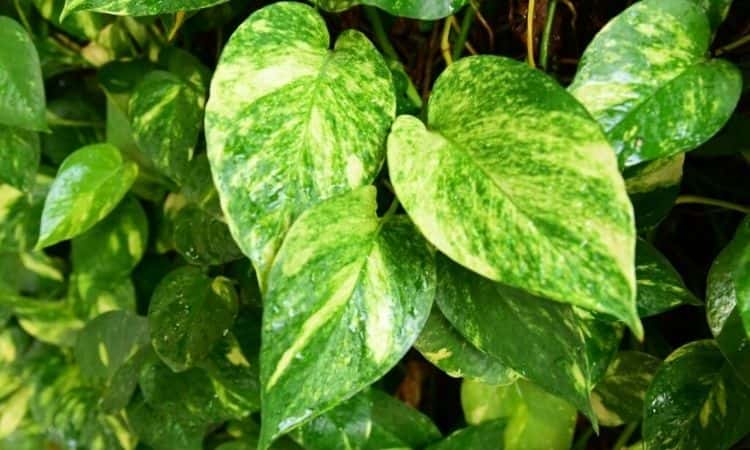Devil’s Ivy (Epipremnum): Expert Tips For Propagating And Growing
The Devil’s ivy likes it warm and can be kept with us only as an indoor plant. Here you will learn everything important about the Epipremnum ewe from buying to care.
Versatile in use, decorative, and easy to care for: this is what the Devil’s ivy describes in a nutshell. The houseplant can be found in many apartments and offices and brings a green and tropical flair to otherwise barren rooms.
Fortunately, the Devil’s ivy mackerel is also extremely robust and undemanding. And so that you really know everything you need to know about the Devil’s ivy, we have compiled expert tips about the houseplant in this article.
Interesting Facts About Devil’s Ivy
Table of Contents
Here you will learn everything about the origin, different varieties, how to buy, repot, care, and toxicity of Epipremnum. The Devil’s ivy hen belongs to the arum family (Araceae) and has been very popular for a long time – no wonder because it is incredibly versatile. Whether as a hanging basket plant, for planting in tubs, as a climbing plant, or as a wall and window planting – everywhere it does very well.
It is also very popular in aquariums because it has the good property of filtering the water and thus improving the water quality in freshwater aquariums. On land, it is also appreciated for its air-improving qualities. Thus the Devil’s ivy can absorb toxins from the ambient air, for example, cigarette smoke or exhaust fumes.
For example, it can absorb and store so much nicotine in its plant parts that the nicotine content in the leaves of the plant can be up to three times higher than in a real tobacco plant. In addition, Devil’s ivy reduces the carbon dioxide content in the air and thus improves the indoor climate. For the greatest possible effect, of course, several plants are needed in one room.
Since the plant stores all these pollutants in its leaves, you should be careful when disposing of them. If you want to get rid of your Devil’s ivy, please only dispose of it in household waste and not in the compost. This is where all the pollutants would accumulate, and you should avoid this.
Another reason why the Devil’s ivy hen is such a popular houseplant: it is very easy to care for and robust. If you have an ivy plant in your room, you can’t really go wrong. Thus also humans without “green thumbs” and plant beginners have the possibility of getting a tropical, evergreen plant into their room or office and of having also long joy in it.
But what is it actually about the name of the Devil’s ivy-birds? They probably owe their name to their similarity to the common ivy (Hedera Helix). After all, both are evergreen climbing plants. But there the similarities stop again because, in contrast to the common ivy belongs to the Araliaceae family (Araliaceae). Further names for the Epipremnum are gold-tendril, tonga-plant, or in English “Pothos”.
Devil’s ivy: Origin and characteristics
Like many popular, evergreen houseplants, the Devil’s ivy comes from the tropics. The different species – there are 15 worldwide – have very different origins in the tropics and subtropics. The popular Golden Ivy (Epipremnum aureum), for example, comes from the island of Moorea in the South Pacific. Other species originate from Malaysia, Indonesia, or Papua New Guinea.
Today, the Epipremnum is widespread everywhere in the tropics and subtropics. The Ivy Guides feel really well in dense, tropical rain forests. There they climb up the larger trees to the treetops and can even grow 20 meters high under these optimal conditions. In our climate, however, Devil’s ivy can only be cultivated indoors.
Devils Ivy is perennial, evergreen plants that grow herbaceously. With good care, they can develop shoots up to ten meters long. They form adventitious roots at the shoot nodes (nodes), with which they can cling to a base, for example, a tree.
The alternate, leathery leaves are heart-shaped and vary in size depending on the species. The color of the leaves also varies greatly with the species and variety. The basic color includes various shades of green and the leaf pattern ranges from striped to patterned in yellow, white, silver, and light green.
The Devil’s ivy hen develops flowers in room culture as good as never. This is due to the fact that the plant must first reach a certain size for flowering and the conditions in the room are simply not optimal for the tropical plant. In tropical rainforests, the Devil’s ivy owes its flowers to a greenish-white cob.
Devil’s Ivy varieties
Worldwide there are 15 different varieties of ivy hares. The probably most popular and best-known species for houseplants are the Golden Ivy (Epipremnum aureum) and the Spotted Ivy (Epipremnum pinnatum). By the way, no true relative of the ivy is the so-called Spotted ivy (Scindapsus pictus), which belongs to another genus of the Araceae.
Obviously, it looks very similar to the Devil’s ivy, but it carries rather silvery foliage with white spots. The choice of the variety influences mainly the appearance of your plant. In the following, we have compiled some recommended varieties for you.
Epipremnum aureum:
- Golden Queen: Probably the most common variety of Devil’s ivy carries golden yellow leaves.
- Glacier: The leaves of this variety are green with white stripes, which are partly grey and silver
- Wilcoxii: This variety has green leaves with a yellow pattern
- Manjula: This variety has white leaves interspersed with light to dark green stripes
Epipremnum pinnatum:
- Marble Queen: The “Marble Queen” convinces with white foliage with green stripes
- Cebu Blue: The elongated leaves of this variety have a silvery green-blue color
- Jade: The leaves of this variety appear in a strong jade-green
- N-Joy: With green leaves, which have a high proportion of white, this variety captivates
- Neon: The leaves of this variety are yellow to light green
You Might Like Emerald Green Vs Global Green
Buy Devil’s ivy
The first step to your own ivy plant hen is of course the purchase. And so that you have something from your tropical roommate for as long as possible, you should pay special attention to certain points so that you don’t get a nasty surprise later on. You can buy Devil’s ivy in hardware stores, garden centers, or on the Internet.
You should pay attention to this when buying your Devil’s ivy:
- Choice of type and variety.
- Vital and healthy impression.
- The plant does not lose leaves.
- No stains or discolorations on the leaves.
- No putrid smell.
- Free from diseases and pests.
Repotting Devil’s Ivy
As easy-care the Devil’s ivy maybe, also it wants to be repotted occasionally. The time for repotting is when the plant’s root network completely fills the flower pot. At the latest, however, you should report your ivy hive once every two to three years.
First, prepare the new pot for the houseplant. The new home for the ivy hive should be slightly larger than the old pot and should have a drain and a coaster. Then you put a drainage layer in the pot with expanded clay or clay fragments. This way the water can always drain off well and there is no waterlogging. Humus-rich potting soil is suitable as a substrate for the Devil’s ivy.
Now take your plant out of its old pot and remove all the substrate from the roots. This can be done by shaking or washing it off. Now you have a good view of the root network and can cut off all rotten or dried root parts. If the root ball is very large, you can also shorten the healthy roots a little. Then place the root ball in the middle of the new pot and cover it with soil. Finally, water the plant well.
- The new pot should be slightly larger than the old one.
- Create a drainage layer.
- Remove the Devil’s ivy from the old pot.
- Carefully shake off or rinse off the earth.
- Pruning roots.
- Place the ivy in the middle of the pot.
- Fill with the substrate.
Once it is repotted, the Devil’s ivy hen comes back to its location. But what does the perfect location for the houseplant actually look like?
The right location for your plant:
- Light to semi-shady.
- Not in the blazing sun.
- Optimum temperature: 20 °C.
- Not colder than 16 °C.
- High air humidity.
- Protected from drafts.

Multiply Devil’s ivy
Since the Devil’s ivy does not flower in the room, cannot reproduce by seed, and does not form offshoots by itself, you must propagate the popular plant yourself. But this is very easy and can be done either by cuttings or offshoots.
For cuttings, a healthy shot of the mother plant is selected, which has formed aerial roots. These are lowered into the substrate and fixed with a wire. As soon as new leaves have developed on the shoot, sufficient roots have been formed and the cuttings can be separated from the mother plant and repotted.
When propagating cuttings, cut off healthy shoots with at least three leaf nodes from the mother plant. These are placed in a special cutting substrate. A plastic bag is put over the pots with the cuttings to create a suitable microclimate. Now the cuttings are placed brightly at 20 °C and the substrate is always kept moist but not wet. As soon as the cuttings are sufficiently rooted, they can be replanted in larger pots.
You Might Like Do Pothos Like to Be Root Bound
If you want to learn more about the Devils ivy propagate, you can read more here.
Care of Devil’s Ivy
Devil’s Ivy hens are very easy to care for and require very little attention. But even the easiest plant cannot survive without water and nutrients. Therefore there are three points that you should take to heart when caring for Devil’s ivy.
Watering
The Devil’s ivy is watered so that the topmost substrate layer always dries. You can check this with your finger. As soon as the top layer in the pot feels dry, you can water again. Alternatively, you can also pour over the coaster.
Cutting
Actually, the Devil’s ivy does not need to be cut regularly. However, if you still want to use scissors, this will not harm the plant, as it is very tolerant of pruning. In general, you can always remove wilted and dead leaves. In order to limit the growth of the plant, you can cut two-thirds of the shoots in spring if they are too long. If you want to encourage the plant to grow more bushy and vigorous, cut the plant along the leaf axes.






